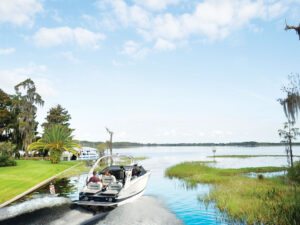The fish man says he doesn’t know exactly where the idea came from. Yeah, he once had a job detailing cars, but that’s not when the thought popped into this former handyman’s head, he claims. “Living on the beachfront in California for 20 years – Newport and Laguna – that’s what inspired me to create these fish.” But “The Fish Man”? What’s the deal with that? Not knowing his real name, many of Todd Guevara’s clients called him “the fish man” when trying to contact him about his work. So 16 years ago he decided to use it for the name of his business. “Saved me a lot of time,” he says.
His business? He makes and sells fiberglass replicas of fish and marine mammals. But the 41-year-old Guevara is by no means a taxidermist; this self-taught designer has used his artistic license with devilish results. Instead of trying to realistically render his fish sculptures, he airbrushes them with patterns of flames – hot rod-style flames, to be exact. Why? Fish have the perfect shape for these designs, he says. It’s true. The graceful curves of their bodies make the ideal backdrop for Guevara’s flame-throwing act.
It’s hard work; in fact, building a fish is much like building the hull of a boat. Guevara first takes a mold of a fish and scrubs it clean. Next he applies a gel coat to the inside of the mold, followed by layers of fiberglass mat and resin. If the sculpture requires more than one molded piece, the pieces are then placed together and bonded. After the fish is released from the mold, it’s time to sand the gel coat. (The fish’s teeth, eyes, and some of the fins are made and installed separately.)
Next Guevara grabs his spray gun and applies as many as six coats of primer to the sculpture. The surface is again sanded and a base coat of color is laid down, followed by a layer of a lightweight, clear “tack coat.” Now comes the fun part. Guevara uses pinstriping tape to outline the edges of the flames, and sprays the background of the flame pattern with opaque white paint. After this dries, he sprays the final colors onto the pattern, applying the same paints that the pros use for automotive custom work. There may be as many as 60 coats of paint used on a single fish. One sculpture can take two months to complete. Brackets to hang the fish on a wall are installed as the last step.
Among Guevara’s billfish series, sailfish are the most popular. A 6′ model weighs about 25 pounds and costs $2,100. He sculpts sharks, too, including great whites, makos, and hammerheads. His best-selling shark, the black tip, costs $1,000 for a 37″ model. Not all of his work is this expensive. For example, he makes a truly audacious 21″ bat ray for only $475.
The Fish Man also designs tuna, dorado, barracuda, flying fish, largemouth bass, and even sea turtles. He performs commissions, too. No, he hasn’t worked on any fiberglass kangaroos or Holstein cows yet, but he has sculpted some stunning replicas of humpback and killer whales. His fish have been used as set pieces in several movies and commercials. You can spy one on the MTV series The Real World.
You don’t have to be a fisherman or a marine biologist to appreciate Guevara’s gel-coated genius, although, he confesses, his wife won’t let him hang any of his fish on the walls of their house. Still, can anyone look at these whimsical super hotties and not crack a big smile? And hey, you know what else? Guevara’s right. Fish should have flames.
For more information: A Boy and His Dog Fine Art Gallery, 619 Duval St., Key West, FL 33040, 305/296-5567, www.thefishman.net.









